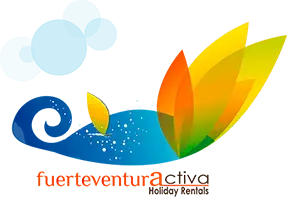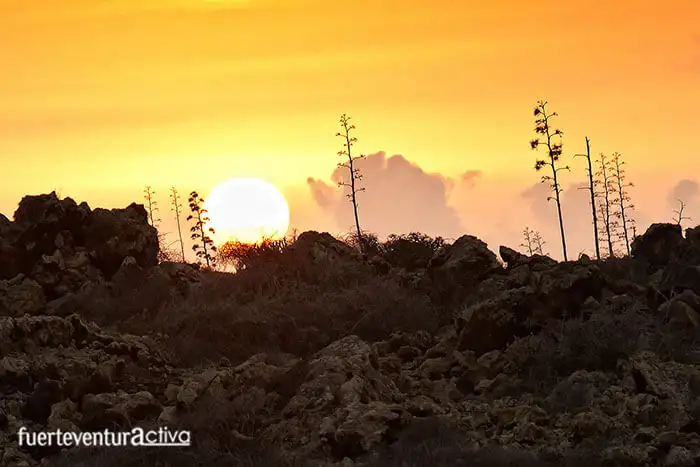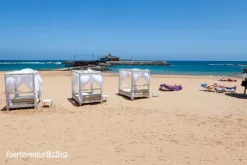LIFE IN FUERTEVENTURA
Piteras in Fuerteventura
The henequenes or piteras are just as well adapted to the Majorero landscape as the tuneras.
These plants are visible and easily recognizable with the naked eye. Its huge stems, more than 10 meters high, rise up creating a peculiar landscape. Walking through a piteral with its masts, some upright and most of them down, is like going through the remains of an ancient battlefield. Or better yet, as if the painting of the Surrender of Breda had come to life and the spearmen, in a hurry, had rushed out, leaving their supplies there.
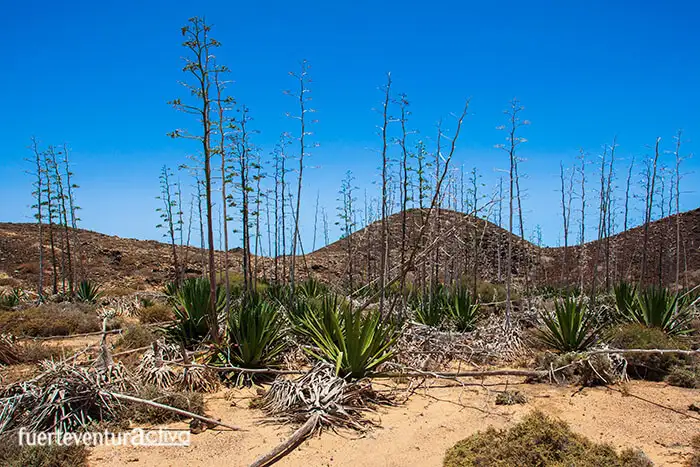
Where does henequen come from?
The pitera is a native species of Central America, specifically of Mexico. It came to the peninsula after the first expeditions of Columbus to the “New World.”
The pitera belongs to the genus of agaves. It grows well in very well-drained and sunny soils, always close to the coast. Its trunk, which can measure almost 2 meters in diameter, has leaves arranged in dense rosettes. The leaves are lanceolate, grayish-green in color with pointed ends. A tall stem that can reach 10-12 meters in height emerges from the rosette.
This trunk is, in fact, an inflorescence, which houses a bunch of greenish-yellow flowers at the top.

It blooms once in its life, between the months of July and September, and this happens around ten years of age. After flowering, the plant dies. Its fruit is an elongated capsule that produces a large quantity of flat black seeds.
Due to its size and its visibility from afar, the pita was used to create the demarcations of the boundaries of roads and estates. It is not until the middle of the 19th century when it begins to be planted extensively.
What were piteras grown for?
Pitas provide abundant cellulosic fibers, which once treated, result in pure cellulose. This cellulose is manufactured by various procedures, obtaining from it viscose, which, stretched into very fine threads, becomes artificial silk or rayon thread, of great tenacity.
This plant came to Fuerteventura on purpose, at the end of the 19th century. It was used as a textile plant to obtain coarse fibers with which to make ropes for boats, hammocks, carpets, rugs, etc. It was also mixed with other textile fibers, such as esparto, cotton, and even silk.
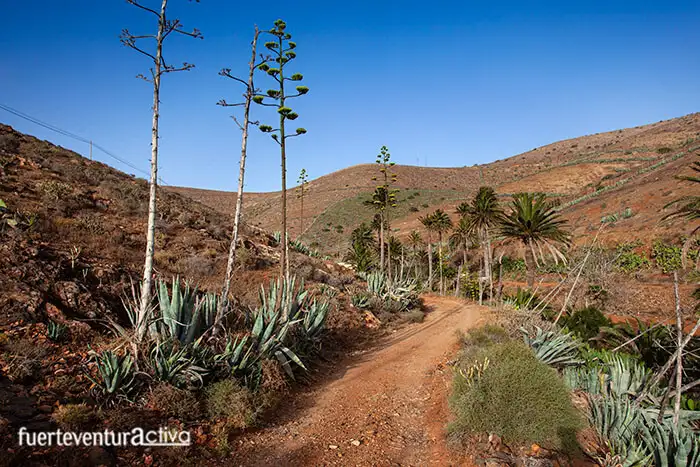
But it was not only used for the manufacture of textiles. According to the Majorero newspaper La Aurora, from 1903, the dry python was used, among other things, to soften the blades of razors, as a float or buoy for people who learned to swim, or to make the roofs of houses and sheds.
Piteras were also used to feed goats, previously removing the tips from the leaves and splitting them into small pieces, several centimeters long.
When did the piteras arrive in Fuerteventura?
Almost all the sisal yarn, which was what the fiber obtained from the piteras was called, was imported from Mexico. It was a very profitable industry, becoming known as “Green Gold of the Yucatan.” The price of pitta fibers increased 20 times in just 3 years, at the end of the 19th century.
The high profitability of the henequen industry, together with the incipient loss of the Spanish colonies, gave rise to the interest in the cultivation of the pitera in our country.
At the beginning of the 20th century, in most of the municipalities of Fuerteventura, there were already pitera plantations. They were brought from both the Bahamas Islands and the Yucatan region.
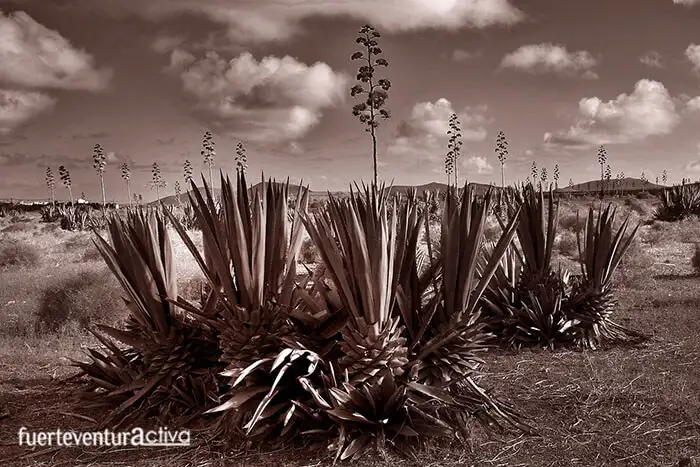
In an article in the La Aurora newspaper, from 1904, we can read:
Pájara has enviable conditions for all kinds of trees. It has flat, rugged, or mountainous terrain. The Tarajal and the Pitera are raised the same as the Palma, the Higuera and the Almendro.
During the first decade of the 20th century, various agronomic investigations were carried out in Fuerteventura, related to the cultivation of cotton and pitera. The studies of Juan Péñate and Jorge V. Pérez of 1910 concluded as follows:
“… this crop and that of the pita, which also thrives there perfectly, will constitute true sources of wealth for that island.”
In the same report, the success of this industry is conditional on the creation of roads. The high cost of transport (by camel) to the port, as well as the double freights, once again ruined the creation of an industry that could make Fuerteventura resurface from a battered economy.
In the mid-twentieth century, the political and economic blockade caused by the Franco dictatorship, originated the attempt of the autarky of Spain, self-sufficient with its own resources. For the manufacture of textile fibers, the Department of Hard Fibers of the Ministry of Agriculture was created, in addition to several agronomic research centers.
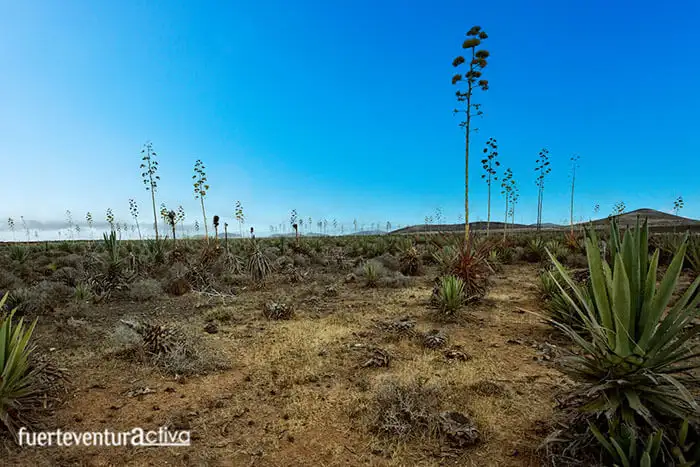
The state bought land in various parts of the municipality of La Oliva and the island of Lobos. In them he planted Agave sisalana, Agave fourcroydes and Agave americana.
The facilities of the old Hard Fibers factory were built at the entrance to Villaverde. This industrial exploitation, unique in the Archipelago, was dedicated to the treatment and commercialization of henequen leaves.
The plant, once cut and cleaned, was exported to various national markets, especially Malaga, where it was used to make cordage and ropes. In the mid-1950s there were two nurseries in the northern municipality with two million henequen plants to meet the enormous demand for this product. There was also financial aid for the promotion of the crop, which granted 100% for the exploitation.
The exploitation of the pitera was an economic boost, in Fuerteventura, until the artificial fibers monopolized the market, thus ending the sisal industry.
Fuerteventura3 Fuerteventura8
